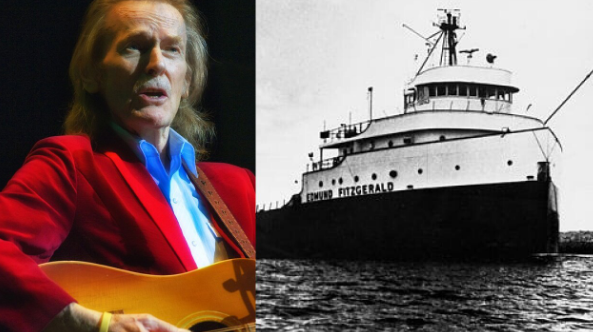Decades ago, in the final verse of his most beloved hit, Gordon Lightfoot depicted a solemn scene at Mariners’ Church of Detroit: “The church bell chimed ’til it rang 29 times / For each man on the Edmund Fitzgerald.”
At 3 p.m. Tuesday, the bell at Mariners’ Church rang out again — now chiming 30 times to honor those perished sailors along with the artist who famously memorialized them in song. – From Detroit Free Press
Gordon Lightfoot’s “The Wreck of the Edmund Fitzgerald” is a haunting ballad that recounts the tragic sinking of the titular Great Lakes freighter on November 10, 1975. The song, which was released in 1976, quickly became a hit and has remained a staple of American folk music ever since. The song’s lyrics vividly describe the events leading up to the ship’s sinking and pay tribute to the 29 men who lost their lives in the disaster.
The song opens with a description of the Edmund Fitzgerald’s departure from Superior, Wisconsin, on November 9, 1975. Lightfoot’s lyrics paint a picture of a powerful vessel that was built to withstand the harsh conditions of Lake Superior. However, as the song progresses, it becomes clear that the ship was no match for the fierce storm that was brewing on the lake that day.
As the storm intensifies, Lightfoot describes the heroic efforts of the Fitzgerald’s crew to keep the ship afloat. The men battled the elements for hours, but their efforts were ultimately in vain. The ship suddenly vanished from radar screens, and it was later discovered that it had sunk to the bottom of the lake, taking all 29 men aboard with it.
One of the most memorable aspects of “The Wreck of the Edmund Fitzgerald” is its chorus, which includes the line “The legend lives on from the Chippewa on down / Of the big lake they call Gitche Gumee.” This line pays homage to the rich cultural history of Lake Superior and its surrounding region, which has long been home to Native American tribes like the Chippewa.
In addition to the song itself, “The Wreck of the Edmund Fitzgerald” is also famous for its connection to the Mariners’ Church in Detroit, Michigan. The church, which was founded in 1842, has long been a hub for the Great Lakes shipping community. Each year on November 10, the church holds a memorial service to honor the crew of the Edmund Fitzgerald and all the other mariners who have lost their lives on the Great Lakes.
After the sinking of the Edmund Fitzgerald, Bishop Richard Ingalls, the pastor of the Mariners’ Church, led a memorial service for the crew members who had lost their lives. The church, which had a long history of ministering to the needs of sailors and their families, had a bell that had been used to signal ships coming into port. In honor of the 29 crew members who had perished in the tragedy, the bell was rung 29 times during the service.
During the service, the church’s bell is rung 29 times, once for each member of the Fitzgerald’s crew. This tradition has been observed every year since the disaster, and it has become an important part of the region’s cultural heritage. The ringing of the bell serves as a reminder of the sacrifices made by the men who worked on the Great Lakes, and it helps to keep their memory alive.
In conclusion, “The Wreck of the Edmund Fitzgerald” is a powerful tribute to the men who lost their lives in one of the Great Lakes’ most tragic disasters. Gordon Lightfoot’s haunting lyrics and melancholy melody capture the sadness and grief felt by the families of the crew members and the wider Great Lakes community. The song’s enduring popularity is a testament to its timeless message and its ability to evoke a strong emotional response from listeners. And the tradition of ringing the bell at the Mariners’ Church ensures that the memory of the Edmund Fitzgerald and its crew will never be forgotten.


